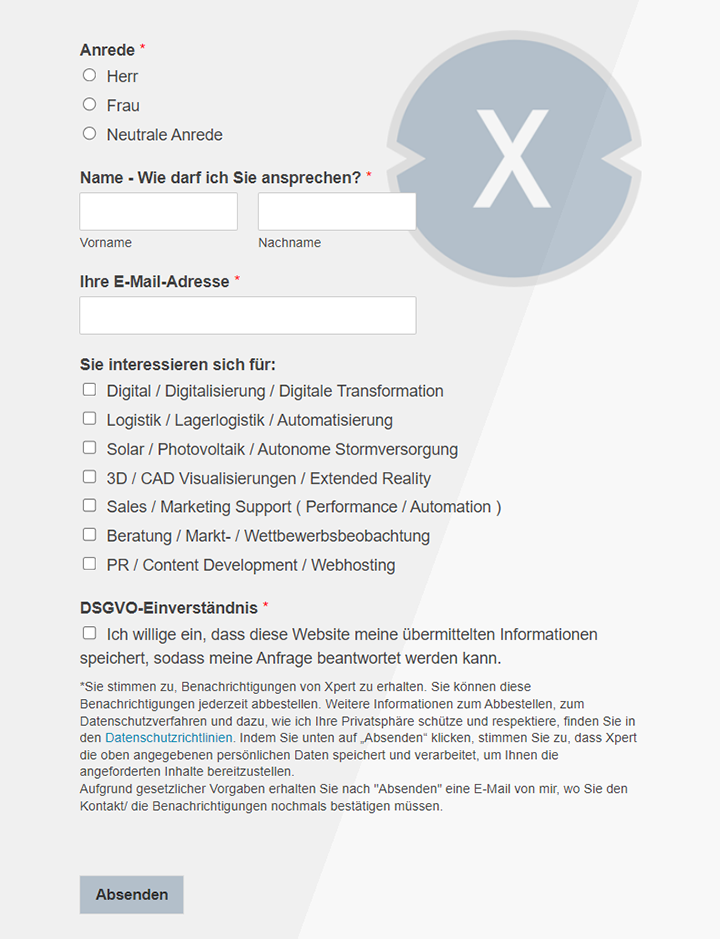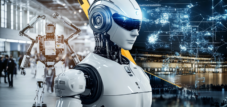Tech turn: China & South Korea dominate robots & chips-alarm for German and European industry?
Xpert pre-release
Language selection 📢
Published on: May 28, 2025 / update from: May 28, 2025 - Author: Konrad Wolfenstein

Tech turn: China & South Korea dominate robots & chips-alarm for German and European industry? - Image: Xpert.digital
AI robot wave: Not only China-South Korea also mixes up Europe! L
Humanoid robots before the breakthrough: China invests billions - Europe is watching?
The current development of the global robotics and semiconductor industry is largely shaped by China's strategic initiative “Made in China 2025”, which causes a fundamental realignment of the international technology landscape. China's aggressive investment in humanoid robots and semiconductor technologies, combined with the increased presence of Korean companies in European markets and the rapid development of AI-based robotic solutions, define a new competitive framework that creates both opportunities and challenges for established industrialized nations. The forecasts for the humanoid robot market, which is to reach a value of 44 billion euros in China by 2031, as well as the increasing integration of robots into service sectors and the development of specialized investment funds underline the transformative power of this technological revolution.
China's strategic realignment in technology leadership
The development of “Made in China 2025”
China pursues a comprehensive strategy for technological independence by re -edition of his “Made in China 2025” initiative, which aims to reduce the dependence on western technologies and to strengthen its own competitiveness. This initiative is continued under a new name to avoid political tensions with western partners, while it unchanged its original goals. The central aspect of the new strategy focuses on the expansion of the manufacturing capacities for semiconductor equipment, which is a crucial step in order to achieve technological autonomy. The Chinese government plans to continue to pursue this strategy as part of the 15th five -year plan from 2026, which underlines long -term commitment on technological leadership.
The original “Made in China 2025” strategy, which was adopted in 2015, formulated ambitious goals for the transformation of China from the “workbench of the world” into a leading industrial night. Up to the 100th birthday of the People's Republic in 2049, the country should rise to the leading “industrial superpower”, whereby the “Made in China” brand should no longer stand for cheap mass goods, but for innovation, quality and efficiency. According to the Chinese media, 86 percent of the minute -listed over 250 individual destinations have already been met. This impressive success rate demonstrates the effectiveness of state -controlled industrial policy and the ability of China to systematically implement long -term strategic goals.
Suitable for:
Technological breakthroughs in the semiconductor industry
The Chinese semiconductor industry shows remarkable progress despite international export restrictions. The increasing demand for high-performance chips for artificial intelligence and the US export controls in the semiconductor area lead to a strong localization of the value chain and an expansion of the supply industry for semiconductor systems in China. The share of sales of the large foreign suppliers in China fell by 5 percentage points to 40 percent in the third quarter of 2024 and is likely to go back to 33 percent in 2025. This development shows the successful substitution of foreign technologies through indigenous alternatives.
The progress in lithographing technology, a key technology for semiconductor production, are particularly noteworthy. While the United States, Japan and the Netherlands have imposed export restrictions on EUV technology in China, Chinese engineers develop their own solutions. A lithograph device from Chinese production was recently presented, which uses a light source with a wavelength of 193 nanometers and achieved a resolution of small or 65 nanometers. These technological breakthroughs significantly reduce China dependence on foreign technologies.
Xiaomi, the cell phone manufacturer, which has recently also been building electric cars, is said to have designed its own semiconductor of the 3-nanometer class. That would be an enormous success and a milestone for the entire chip industry in the country, since the Chinese had almost drawn the same with the most successful chip manufacturers in the earth such as Samsung, Intel or TSMC at least on the design level. This development underlines the rapid catching up of Chinese companies in critical technology areas.
China's dominance in the humanoid robot market
Market leadership and technological innovation
China has established itself as an undisputed market leader in humanoid robots. At the world robot conference in Beijing, 27 human -like robots were presented, with all the models of Chinese companies presented to the Optimus of Tesla. This overwhelming dominance of Chinese manufacturers at the most important robot conference in the world illustrates the country's technological management position in this forward -looking sector.
UNITREE, a start-up from the southern Chinese city of Hangzhou, attracted a lot of attention than one of the first companies worldwide to launch a humanoid robot. The G1 robot from UNTREE, which was presented in May, is scheduled to go into series production in the fourth quarter of 2024. Thanks to artificial intelligence, the G1 can do simple tasks such as cracking walnuts and is offered for 99,000 Yuan (around CHF 14,000). This pricing makes humanoid robots accessible for the first time for a wider target group.
The Chinese market for humanoid robots is growing rapidly, with forecasts that expect a market value of 44 billion euros by 2031. This explosive growth forecast reflects both state support and the technological advances of Chinese companies. In addition to UNTREE, other Chinese companies such as Ubtech with the Walker S and Kepler with the Forerunner Humanoid robot have also developed, which are to be launched by the end of 2024. These robots target industrial applications and could work on the assembly line or take on sorting tasks.
Competition advantages and cost efficiency
China's competitive advantages in the robot area are based on several structural factors. The strong support from the Chinese government and the well-developed supply chain for robotics components give Chinese companies a decisive advantage. Thomas Andersson from the research company Stiq is closely observing the Humanoid robot's market and sees China as a leader in this area. Chinese industrial policy follows a proven pattern: over-investment, overproduction and overcapacity enable products to be sold on the world market at favorable dumping prices.
A major cost advantage of Chinese robots is shown in pricing. In western markets, the robots from China could be 20 to 50 percent cheaper than the competition. This cost efficiency results from complete control over the domestic value chain. A Chinese entrepreneur explains: "In China we can cover the entire domestic value chain-from chip production to module design to software and algorithms". This vertical integration enables Chinese companies to both reduce costs and to control the quality.
The robotics industry benefits from government funding through subsidies, tax advantages and cheap loans. Robotics companies in China shoot out like mushrooms in China, supported by a coordinated industrial policy that coordinates all areas of supply chain, research and development. This systematic approach makes it possible to use synergies across the entire industrial chain and to concentrate together on the development of advanced robot technologies.
🎯🎯🎯 Benefit from Xpert.Digital's extensive, fivefold expertise in a comprehensive service package | R&D, XR, PR & SEM

AI & XR 3D Rendering Machine: Fivefold expertise from Xpert.Digital in a comprehensive service package, R&D XR, PR & SEM - Image: Xpert.Digital
Xpert.Digital has in-depth knowledge of various industries. This allows us to develop tailor-made strategies that are tailored precisely to the requirements and challenges of your specific market segment. By continually analyzing market trends and following industry developments, we can act with foresight and offer innovative solutions. Through the combination of experience and knowledge, we generate added value and give our customers a decisive competitive advantage.
More about it here:
Korean robotics: strategic expansion to the European market
Korean companies as a bridge to the European market
Strategic market development in Europe
Korean robot manufacturers have identified the European market as a strategic growth area and systematically establish their presence. Doosan Robotics opened its European headquarters in Düsseldorf, which is the result of increasing demand for Doosan's collaborative robots (Cobots) in Europe. These cobots work with people and take on simple tasks in different areas, including in palletizing, welding or loading and unloading machines. In addition to the headquarters, a service center for installations or repairs was set up at Heerhugoward in Dutch.
Hanwha Robotics has continuously expanded his distributor network in the past two years, whereby the company focuses primarily on European space. The Europe partner Days from Hanwha Robotics in Frankfurt were all about the European distributors of the Korean manufacturer of Cobots HCR-3, HCR-5 and HCR-12. Hanwha Robotics currently has a network with 20 distributors worldwide, with the company's cobots mainly used in the applications of mechanical loads, palletizing and handling/assembly.
HD Hyundai Robotics demonstrated its presence at the Motek Messe in Stuttgart, where the company presented its advanced products, including the Hyundai Service Robot and the Minibot. These activities show the strong commitment of Korean companies to establish their advanced robot technologies on the European market and to build strategic partnerships.
Technological innovation and market positioning
By their ability to combine innovative technologies with practical applications. South Korea's robotics industry makes a significant leap forward with the development of artificial intelligence technology, which transforms traditional industrial robots into progressive counterparts that can understand and execute human commands. This innovation enables workers who are not familiar with robots to simply use them, which can improve productivity in the production industry as a whole.
The versatility of Korean AI robots is evident in their ability to maintain commands not only through language, but also through text, which means that people can program work processes in simple terms without technical expertise. This technology is currently being tested in an electronic parts factory in Cheongju, with promising results that suggest a future in which people and robots work together seamlessly. If the effectiveness of the robot is confirmed, this could usher in a new era of production, in which intelligent robots and human workers work hand in hand and increase productivity and efficiency in an unprecedented way.
South Korea positions itself as a top manufacturer country with great potential for the “AI robotics fusion”, whereby the cooperation between AI and robotics is viewed as a revolutionary. Companies such as LG Electronics and Hyundai Motor Group are industry leaders in the revolution of autonomous delivery robots. LGS Cloi Serebot and Hyundais DAL-E exemplify the advanced skills of modern delivery robots and show the versatility and the potential of autonomous robots in various sectors.
Suitable for:
Robotics in the service sector: Innovation and application expansion
Progress in gastronomic automation
The service sector experiences a remarkable transformation through the integration of advanced robot technologies. Richtech Robotics has expanded the skills of his AI-based barista robot Adam with a new manual espresso system. The new manual coffee system has devices that can be found in cafes worldwide, including a precision mill, dosing and tamper devices as well as a hand-pressed espresso machine. This upgrade introduces a new level of intelligence by using Adam's physical AI skills to monitor and control the endurance process in real time.
Adam's technological sophistification shows in its ability to use Nvidia-based AI vision to observe the water pressure during the extraction and to adapt precisely to optimize every espresso. This interaction between perception and control goes beyond basic automation and demonstrates how AI can bring precision, adaptability and consistency to traditionally manual tasks. With this upgrade, the company shows that automation does not require any compromises in quality.
Adam uses AI-based image processing to recognize when a customer approaches and then begins in real time with the explanation of the individual steps of the process. This interactive component transforms the robotics from purely functional automation to a customer -oriented experience that offers both efficiency and commitment. The advanced physical AI skills of Adam offer companies the opportunity to serve high-quality, handmade drinks and at the same time ensure the efficiency of the work processes and stable staffing.
Various areas of application of autonomous service robots
South Korean companies have demonstrated several successful implementations of autonomous service robots. LGS Cloi service was used extensively in hospitals and restaurants, where he provides meals and medical care with precision and reliability. These robots have proven to be particularly advantageous to reduce human contact and to improve operational efficiency during COVID-19 pandemic. The practical applications show how service robots not only enable efficiency gains, but can also contribute to maintaining services in critical situations.
Hyundais DAL-E robot was used in retail stores, where he improves the customer experience through personalized support and information. The ability of the robot to recognize faces and react to voice commands makes it a valuable activation in creating a seamless and interactive shopping experience. These successful implementations in South Korea serve as a model for other countries that want to integrate autonomous solutions into their logistics and customer service operations.
The future of autonomous delivery robots looks promising, with ongoing progress in AI and robotics that are supposed to drive a further adoption. South Korea is well positioned to lead this growth, since the strong technological infrastructure of the country, combined with its innovative companies and supportive regulatory environment, creates an ideal ecosystem for the development and use of autonomous robots.
🎯📊 Integration of an independent and cross-data source-wide AI platform 🤖🌐 for all company matters

Integration of an independent and cross-data source-wide AI platform for all company matters-Image: Xpert.digital
Ki-Gamechanger: The most flexible AI platform-tailor-made solutions that reduce costs, improve their decisions and increase efficiency
Independent AI platform: Integrates all relevant company data sources
- This AI platform interacts with all specific data sources
- From SAP, Microsoft, Jira, Confluence, Salesforce, Zoom, Dropbox and many other data management systems
- Fast AI integration: tailor-made AI solutions for companies in hours or days instead of months
- Flexible infrastructure: cloud-based or hosting in your own data center (Germany, Europe, free choice of location)
- Highest data security: Use in law firms is the safe evidence
- Use across a wide variety of company data sources
- Choice of your own or various AI models (DE, EU, USA, CN)
Challenges that our AI platform solves
- A lack of accuracy of conventional AI solutions
- Data protection and secure management of sensitive data
- High costs and complexity of individual AI development
- Lack of qualified AI
- Integration of AI into existing IT systems
More about it here:
The global robotics landscape: strategies for investors
Investment landscape and financial market trends
Specialized ETFs and market development
The financial market reacts to the growing importance of the robotic industry with specialized investment products. Mirae Asset Asset Management announced the listing of a new “Tiger China Humanoid Robot ETF” at the Korea Exchange. This ETF invests in China's value chain, including Chinese humanoid robot companies with technological competence and cost advantages under the foundation of the world's largest robot production industry and key components that are essential for humanoid production.
The ETF is based on the Mirae Asset China Humanoid Robot Index, which includes Chinese humanoid robot companies that are noted in China and Hong Kong. The most important investment stocks include Ubtech, Shenzhen Innovation Tech and Iflytek. China is described as a country with rapidly growing AI technology and humanoid robot industry, which has been concentrated on the robot industry since the 2010s and promotes humanoid robots as the next growth engine. The country is currently the largest producer and largest consumer of industrial robots worldwide.
The Chinese government shows a strong willingness to become a leading country in the humanoid robot market by announcing a policy for promoting humanoids under their policies to localize central production capacities. Accordingly, it is expected that China's inexpensive, powerful robot industry is being seriously developed. The ETF enables investors to invest in the entire value chain through a single product, including companies that produce complete robots, as well as raw material and parts companies.
State funding and investment strategies
China has implemented extensive state support measures for the robotic industry. The state-based national semiconductor investment fund recently completed its second investment round of up to 300 billion Yuan (39 billion euros). The money should flow into the entire production chain of the domestic semiconductor industry, but especially into the area of chip design. Between 2015 and 2017, 15 risk capital funds with a total volume of around 21 billion yuan (2.7 billion euros) were set up with the help of the national fund for technology transfer and commercialization.
These funds are intended to make innovations in research and technology in core areas of “Made in China 2025” accessible to industrial use, for example in the field of biomedicine or manufacturing of high -quality machines. The establishment of an internationally competitive innovation ecosystem plays a central role for the success of “Made in China 2025”. By 2025, a comprehensive network of 40 national production of production centers and a large number of supportive facilities are to be created at the provincial level.
The government will also advertise among the Chinese users for local robot brands and help to sensitize the public for Chinese robots and to develop confidence in the robots manufactured in China. An official of the Ministry of Industry and Information Technology said that politics will include subsidies for companies to buy locally produced brand robots, as well as a national fund that is intended to help Chinese robot manufacturers to acquire advanced technologies worldwide.
Suitable for:
- Currently the largest humanoid robotics study by Xpert.digital-Marktboom ahead: from robot prototypes to practice
Strategic challenges for established industrialized nations
European competitive position
Europe and Germany in particular face considerable strategic challenges in the face of the Chinese offensive in the robotics industry. An expert from Paderborn, who observes the robot market, states: "We don't have so many robot manufacturers here in Germany and in Europe. We have startups that may be counted on one hand. We sold our largest robot manufacturer Kuka to China". This development illustrates the dwindling industrial basis in Europe in a critical future sector.
China has been investing very strongly in robotics and very strategically with a very long -term plan for many years. The Chinese robots are not only “cheap goods”, but actually robots that have been inspired by the European or Japanese manufacturers. If China's industry thinks, robots from abroad first copied, then optimized. Made in China is no longer just for inferior cheap goods, but also for inexpensive high -tech.
The People's Republic already has two thirds of the patents worldwide in robotics, which is more than 190,000. This overwhelming patent dominance shows the technological management position of China and the challenge for European companies to compete in this area. On comparison platforms, the Chinese robot arms are at least 20 to 25 percent cheaper than the European or Japanese, with some models that are up to 40 percent cheaper.
Market forecasts: Why humanoid robots will only dominate in industry for the time being
The long -term market prospects for humanoid robots show a mixed timeline for different areas of application. Experts estimate that it will take at least a decade before humanoid robots can be integrated into our everyday life. Humanoid robots get along better in orderly factories than in the private environment, and experts assume that it will still take 5 to 8 years before the robots are so fit that they can fully integrate into a household.
China's ambitious goals stipulate that humanoid robots should make a significant contribution to economic growth as early as 2027. According to the government timetable, China is to begin mass production by humanoid robots in 2025, and as early as 2027, the human -like machines are to be integrated in the real economy. This aggressive timeline shows China's ambitions to dominate the humanoid robot market before other countries can build their own production capacities.
Industrial applications will probably be the first areas in which humanoid robots are widely used. Companies such as Tesla, BMW and Hyundai are very investing in the development of humanoid robots for use in factories and storage. Tesla plans to produce thousands of humanoid robots this year, which are intended to take on useful tasks in their factories. These industrial applications will serve as a springboard for later integration into other sectors.
Asia's technology offensive: strategies for western success
The analysis of current developments in the global robotics and semiconductor industry reveals a fundamental shift in technological power relationships, which is shaped by China's strategic initiative “Made in China 2025” and the dynamic expansion of Korean companies. China's systematic approach to technological independence, combined with massive state investments and a fully integrated value chain, has made the country a dominant force in the humanoid robot market. The fact that 86 percent of the original goals of “Made in China 2025” have already been achieved underlines the effectiveness of long -term strategic planning and state coordination.
The Korean companies act as an important bridge between Asian innovation and European markets, whereby their expertise in the AI robotics fusion sets new standards for the integration of artificial intelligence and robotic systems. The successful implementation of service robots in various sectors, from gastronomy to retail, demonstrates the immense potential for transformation of traditional service sectors. At the same time, the development of specialized investment funds and ETFs shows the growing trust of the financial markets in the long -term profitability of these technologies.
For established industrialized nations, especially in Europe, this results in both challenges and opportunities. The dwindling industrial basis in robotics production and the overwhelming patent dominance of China require a strategic realignment of European technology policy. The forecast that humanoid robots should make a significant contribution to economic growth as early as 2027, while their complete integration into households still takes 5 to 8 years, offers European companies a limited time window for strategic investments and partnerships. The future will depend on whether Western industrialized nations will find innovative answers to the Asian technology offensive or whether you have to be satisfied with a subordinate role in the global value chain.
We are there for you - advice - planning - implementation - project management
☑️ SME support in strategy, consulting, planning and implementation
☑️ Creation or realignment of the digital strategy and digitalization
☑️ Expansion and optimization of international sales processes
☑️ Global & Digital B2B trading platforms
☑️ Pioneer Business Development
I would be happy to serve as your personal advisor.
You can contact me by filling out the contact form below or simply call me on +49 89 89 674 804 (Munich) .
I'm looking forward to our joint project.
Xpert.Digital - Konrad Wolfenstein
Xpert.Digital is a hub for industry with a focus on digitalization, mechanical engineering, logistics/intralogistics and photovoltaics.
With our 360° business development solution, we support well-known companies from new business to after sales.
Market intelligence, smarketing, marketing automation, content development, PR, mail campaigns, personalized social media and lead nurturing are part of our digital tools.
You can find out more at: www.xpert.digital - www.xpert.solar - www.xpert.plus





























